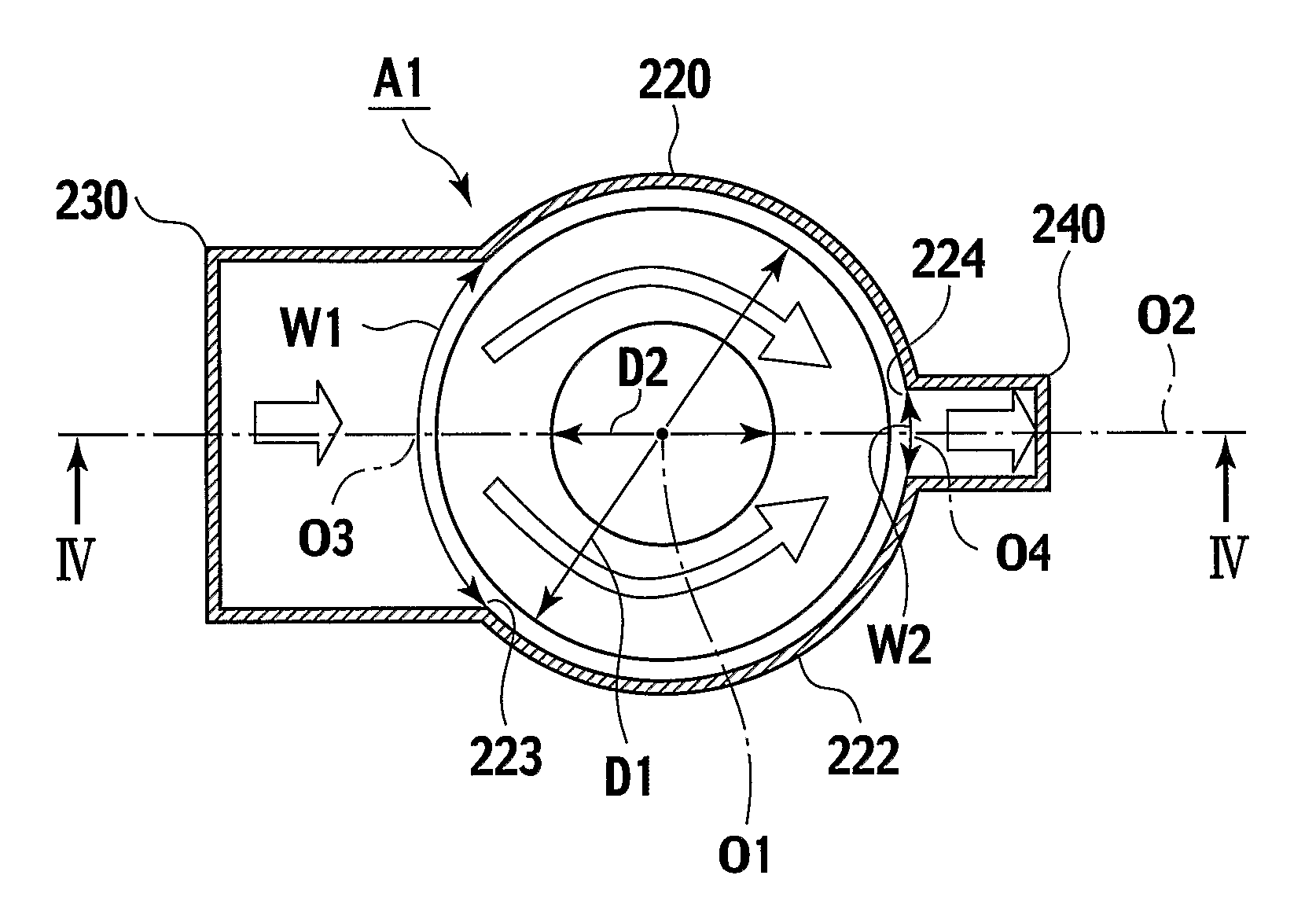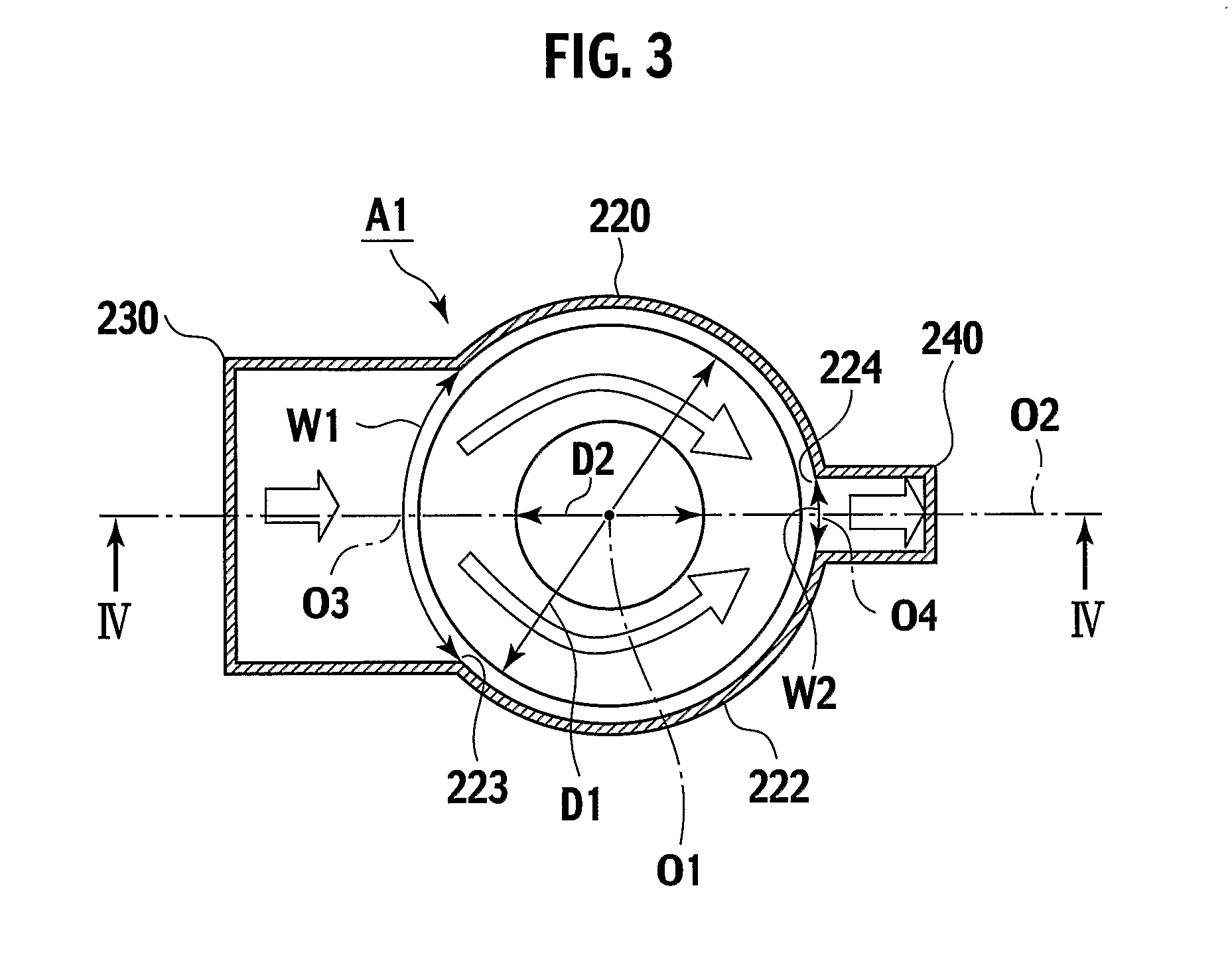Fuel cell
a fuel cell and cell technology, applied in the field of fuel cells, can solve the problems of insufficient thermal shock resistance, difficult to distribute reactant gas uniformly in the layer, and insufficient generation of power in the region, and achieve the effect of efficiently extracting generated power
- Summary
- Abstract
- Description
- Claims
- Application Information
AI Technical Summary
Benefits of technology
Problems solved by technology
Method used
Image
Examples
first embodiment
[0047]A fuel cell A1 according to a first embodiment of the present invention will be described in detail with reference to FIG. 1 to FIG. 5.
[0048]The fuel cell A1 includes a stack-structured member B and a casing 210 for housing the stack-structured member (hereinafter simply referred to as a “cell stack”) B. Two kinds of reactant gases flow separately from each other inside the cell stack B and inside the casing 210. The fuel cell A1 generates power by receiving the supply of these reactant gases.
[0049]The cell stack B includes multiple solid electrolyte fuel cell units 200 which are stacked in a stacking direction while providing inter-unit spaces S between the respective units.
[0050]Here, the expression “to stack” means to stack the multiple solid electrolyte fuel cell units (hereinafter simply referred to as “cell units”) 200 while providing the inter-unit spaces S between the respective units.
[0051]The “inter-unit spaceS” is provided to have one reactant gas out of the two kin...
second embodiment
[0082]Next, a fuel cell A2 according to a second embodiment of the present invention will be described with reference to FIG. 6 to FIG. 9.
[0083]The fuel cell A2 includes a cell stack 11 and a casing 10 for housing the cell stack 11. The casing 10 includes a casing body 12 that surrounds the cell stack 11, and a gas introduction portion 12A and a gas discharge portion 12B which are provided in a protruding manner on mutually opposite side surfaces of the casing body 12.
[0084]The casing body 12 includes: a bottom plate 12c having a circular shape in a plan view, and covering one end side (a lower end side) in the stacking direction of the cell stack 11; a peripheral wall 12d extending upward in the stacking direction from a peripheral portion of the bottom plate 12c along a side surface of the cell stack 11, and surrounding the side surface of the cell stack 11; and a lid member (an upper plate) 12e being welded over the entire periphery onto an upper end edge of the peripheral wall 1...
third embodiment
[0133]FIG. 12 to FIG. 14 show a fuel cell according to a third embodiment of the present invention.
[0134]A fuel cell A3 according to this embodiment has a configuration to provide a casing body 72 (a plate thickness of 0.5 mm) made of stainless steel (SUS310, JIS) with two gas inlet openings 72a and one gas outlet opening 72b. The total opening width dimension W1 of the two gas inlet openings 72a is set greater than the total opening width dimension W2 of the gas outlet opening 72b.
[0135]Two gas introduction portions 72A and one gas discharge portion 72B are provided in a protruding manner beside the casing body 72. Configurations of the respective gas introduction portions 72A and the gas discharge portion 72B are similar to those in the above-described embodiments.
[0136]In this embodiment, a gas flow-regulating member is formed of a ceramic sheet 77 attached to an inner side surface of a metal corrugated plate 76. As shown in FIG. 13, the metal corrugated plate 76 has a plate thi...
PUM
 Login to View More
Login to View More Abstract
Description
Claims
Application Information
 Login to View More
Login to View More - R&D
- Intellectual Property
- Life Sciences
- Materials
- Tech Scout
- Unparalleled Data Quality
- Higher Quality Content
- 60% Fewer Hallucinations
Browse by: Latest US Patents, China's latest patents, Technical Efficacy Thesaurus, Application Domain, Technology Topic, Popular Technical Reports.
© 2025 PatSnap. All rights reserved.Legal|Privacy policy|Modern Slavery Act Transparency Statement|Sitemap|About US| Contact US: help@patsnap.com



